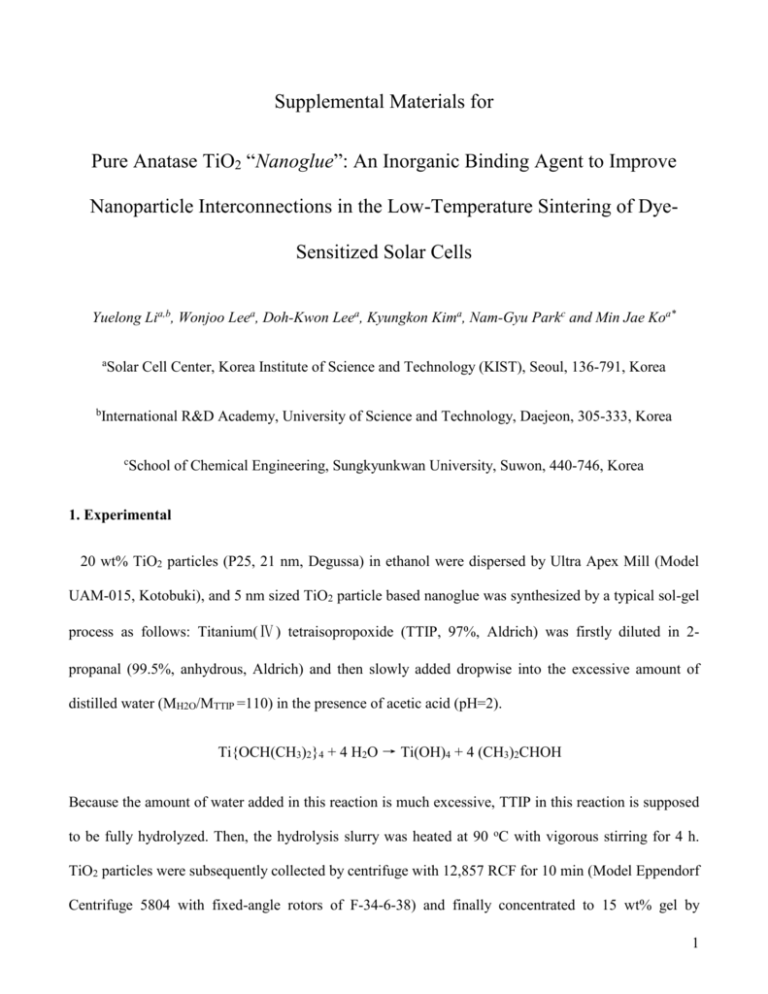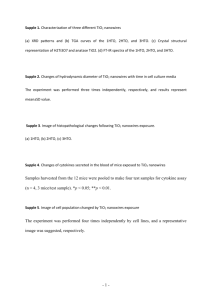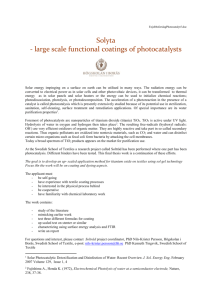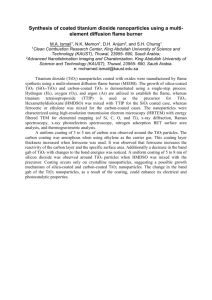Template for Electronic Submission to ACS Journals
advertisement

Supplemental Materials for
Pure Anatase TiO2 “Nanoglue”: An Inorganic Binding Agent to Improve
Nanoparticle Interconnections in the Low-Temperature Sintering of DyeSensitized Solar Cells
Yuelong Lia,b, Wonjoo Leea, Doh-Kwon Leea, Kyungkon Kima, Nam-Gyu Parkc and Min Jae Koa*
aSolar
Cell Center, Korea Institute of Science and Technology (KIST), Seoul, 136-791, Korea
bInternational
cSchool
R&D Academy, University of Science and Technology, Daejeon, 305-333, Korea
of Chemical Engineering, Sungkyunkwan University, Suwon, 440-746, Korea
1. Experimental
20 wt% TiO2 particles (P25, 21 nm, Degussa) in ethanol were dispersed by Ultra Apex Mill (Model
UAM-015, Kotobuki), and 5 nm sized TiO2 particle based nanoglue was synthesized by a typical sol-gel
process as follows: Titanium(Ⅳ) tetraisopropoxide (TTIP, 97%, Aldrich) was firstly diluted in 2propanal (99.5%, anhydrous, Aldrich) and then slowly added dropwise into the excessive amount of
distilled water (MH2O/MTTIP =110) in the presence of acetic acid (pH=2).
Ti{OCH(CH3)2}4 + 4 H2O → Ti(OH)4 + 4 (CH3)2CHOH
Because the amount of water added in this reaction is much excessive, TTIP in this reaction is supposed
to be fully hydrolyzed. Then, the hydrolysis slurry was heated at 90 oC with vigorous stirring for 4 h.
TiO2 particles were subsequently collected by centrifuge with 12,857 RCF for 10 min (Model Eppendorf
Centrifuge 5804 with fixed-angle rotors of F-34-6-38) and finally concentrated to 15 wt% gel by
1
adjusting the amount of solvent which is from sol-gel synthesis process and mainly contains water and
small amount of 2-propanal with acetic acid. The 15 wt% TiO2 gel was defined as nanoglue. In the
nanoglue, TiO2 particles with a diameter of about 5 nm were formed by polycondensation between fully
hydrolyzed Ti(OH)4 molecules at a specific condition (such as the amount of water, pH and reaction
temperature). Subsequent dehydration between hydroxyl group on the surface of P25 TiO2 particles and
that of primary particles from nanoglue, could further take place, and then form Ti-O-Ti bonds between
TiO2 particles. The viscous alcoholic paste for coating TiO2 layer was prepared by mixing 20 wt% P25
TiO2 alcoholic solution with 15 wt% TiO2 nanoglue, followed by sonication and vigorous shaking for 10
min where the weight ratio of TiO2 particles from P25 solution and nanoglue was fixed at 7:1. TiO2
photoelectrode film with thickness of about 7 μm was coated by a doctor blade method with 3M tapes as
a spacer onto a transparent conducting glass substrate (8 Ω/sq, 2.3 mm thick, Pilkington TEC8).
After drying at ambient temperature, TiO2 films were further sintered at 150 oC for 1 h and then
slowly cooled to 80 oC, which were then immersed into 0.5 mM N719 (cis-bis (isothiocyanato) bis (2,
2`-bipyridyl-4, 4`-dicarboxylato)-ruthenium (II) bis-tetrabutylammonium, Everlight) anhydrous ethanol
solution for dye loading at 50 oC for 2 h with continuous shaking. The amount of dye absorption was
estimated by desorbing the dye from the sensitized films with a known area in a measured volume of
NaOH aqueous solution and by measuring its absorption spectra. In comparison, TiO2 electrodes
without adding nanoglue were also prepared from bead milled 20 wt% P25 solution and treated with the
same procedure as above.
A Pt coated FTO/glass as a counter electrode was prepared by thermal reduction of a thin film formed
from 7 mM of H2PtCl6 in 2-propanol solution at 400 oC for 20 min. The two electrodes were assembled
using 25 µm-thick Surlyn (Dupont 1702). An electrolyte solution was introduced through a drilled hole
on the counter electrode, which was composed of 0.7 M 1-propyl-3-methyl-imidazolium iodide (PMII),
0.03 M I2, 0.05 M guanidinium thiocyanate (GuSCN) and 0.5 M 4-tert-butylpyridine (tBP) in the
2
mixture of acetonitrile and valeronitrile (v/v=85:15). The active cell area was about 0.45 cm2, which was
measured by an image analysis program equipped with a digital microscope camera (Moticam 1000).
High resolution transmission electron microscope (HR-TEM) was obtained using Field Emission Gun
equipped TEM instruments (FEI Tecnai F20, Philips Electron Optics, Holland). Powder X-ray
diffraction (XRD) was carried out with the Rigaku D/max-2500 diffractormeter using CuKα radiation
with a wavelength of 0.154 nm, and a voltage and a current of 40 kV and 100 mA, respectively.
Photocurrent-voltage measurements were performed using the Keithly model 2400 source measure unit.
A solar simulator (Newport) equipped with a 1000 W Xenon lamp was used as a light source, where the
light intensity was adjusted with the NREL-calibrated Si solar cell with the KG-1 filter for
approximating 1 sun light intensity. A black mask with proper aperture size was covered onto a cell to
exclude the diffused light during measurement. For the photocurrent transient study, the cells were
probed with a weak laser pulse at 532 nm superimposed on a relatively intense background (bias)
illumination at 680 nm by a 0.5 W diode laser (Model: BWF1-670-300E/55370, B&W TEK Inc.) by
using setup similar to the reported one.1
1Kopidakis,
N.; Benkstein, K. D.; Van de Lagemaat J.; Frank, A. J. Transport-Limited Recombination of
Photocarriers in Dye-Sensitized Nanocrystalline TiO2 Solar Cells. J. Phys. Chem. B. 2003, 107, 1130711315.
3








